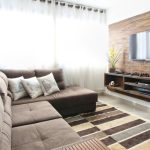How to Select the Perfect Area Rug Size
Selecting the perfect area rug size can transform a room, adding warmth, style, and cohesion. However, with so many options available, choosing the right size can be a daunting task. An area rug should complement your space, serve a functional purpose, and enhance your decor. This guide will help you navigate the process, ensuring that your rug enhances your living area beautifully.
Understanding Room Dimensions
Before you even think about the rug itself, take precise measurements of your room. Knowing the dimensions will help you visualize the space and determine how much area you want to cover. Use a tape measure to measure the length and width of the room, and note any architectural features like fireplaces or built-in shelving that might influence your rug placement.
Once you have your measurements, consider the layout of your furniture. A rug that is too small can make a space feel disjointed, while one that is too large can overwhelm the room. Take a moment to arrange your furniture in a way that feels comfortable and balanced. This will guide you in deciding how much space you want the rug to occupy.
Rug Sizing Guidelines
There are general guidelines when it comes to selecting rug sizes that can serve as a foundation for your decision.
For living rooms, a common approach is to ensure that at least the front legs of your furniture are on the rug. This creates a unified look and helps define the seating area. A common size for medium to large living rooms is an 8×10 or 9×12 rug, depending on the scale of your furniture. If you have a more open layout, consider a larger rug that allows for all furniture to sit comfortably on it.
In dining rooms, the rug should extend beyond the edges of the dining table to accommodate chairs being pulled out. A good rule of thumb is to add at least 24 inches to each side of the table. For example, if you have a 6-foot dining table, look for a rug that is at least 8×10 feet to provide ample space.
Bedroom rugs should ideally stretch beyond the sides of the bed, providing a soft landing area when you step out of bed. A common choice is a 5×8 or 8×10 rug placed under the bed, depending on the size of your bed and the space available.
Creating Zones with Rugs
One effective way to use area rugs is by creating distinct zones within a larger room. In open floor plans, rugs can help define different areas, such as a seating area versus a dining area. When using multiple rugs in one space, ensure they are of similar styles or colors to maintain a cohesive look.
For example, in a large living area, you might choose a plush, larger rug under the seating area and a smaller, patterned rug to define a reading nook. Utilize rugs as visual anchors that guide the flow of the space, allowing each zone to feel connected yet distinct.
Choosing the Right Shape
Area rugs come in various shapes, and the shape you choose can significantly impact the room’s aesthetic. Rectangular rugs are the most versatile and work well in most settings. However, round rugs can soften the lines of a room and are particularly effective in dining areas or smaller spaces.
Square rugs can create a modern vibe in larger rooms, while runners are perfect for hallways or narrow spaces. Think about the layout of your furniture and how the shape of the rug will fit into that design.
Color and Pattern Considerations
Once you’ve settled on a size and shape, consider the color and pattern of the rug. The rug should complement your existing decor and set the tone for the room. If your space is filled with bold colors and patterns, a solid neutral rug can provide a calming balance. Conversely, if your room is more subdued, a vibrant patterned rug can serve as an eye-catching focal point.
Think about the moods you want to evoke. Warmer tones can create an inviting atmosphere, while cooler colors can add a sense of tranquility. Patterns can also play a role; geometric designs can bring a modern edge, while floral patterns can evoke a more traditional feel.
Texture Matters
The texture of your rug is equally important as its size. Different materials can create various visual effects and tactile experiences. For instance, a plush shag rug can add comfort and coziness to a living room, while a flatweave rug can lend a more casual, laid-back vibe.
Consider the foot traffic in the area where the rug will be placed. High-traffic areas may benefit from durable materials like wool or synthetic fibers, which are resistant to wear and easy to clean. In contrast, a softer rug might be perfect for a bedroom or reading area, where comfort is paramount.
Testing the Space
Once you’ve narrowed down the size, shape, and style of your rug, it’s helpful to visualize how it will look in your space. If you’re unsure about the size, use painter’s tape to outline the dimensions of the rug on the floor. This gives you a visual representation of how the rug will occupy the space and allows you to reassess your choices before making a purchase.
Alternatively, if you’re shopping in-store, don’t hesitate to measure the rug and lay it out in the desired area. This hands-on approach can provide clarity on how the rug fits with your furniture and decor.
Final Thoughts on Rug Selection
Selecting the perfect area rug size is a blend of art and science. By understanding your space, considering the layout, and keeping in mind the style and texture of the rug, you can make an informed decision that enhances your home. The right rug not only adds warmth and comfort but also brings together the various elements of your decor, creating a cohesive and inviting atmosphere. Take your time, experiment with options, and enjoy the process of finding a rug that reflects your personal style and meets your functional needs.


